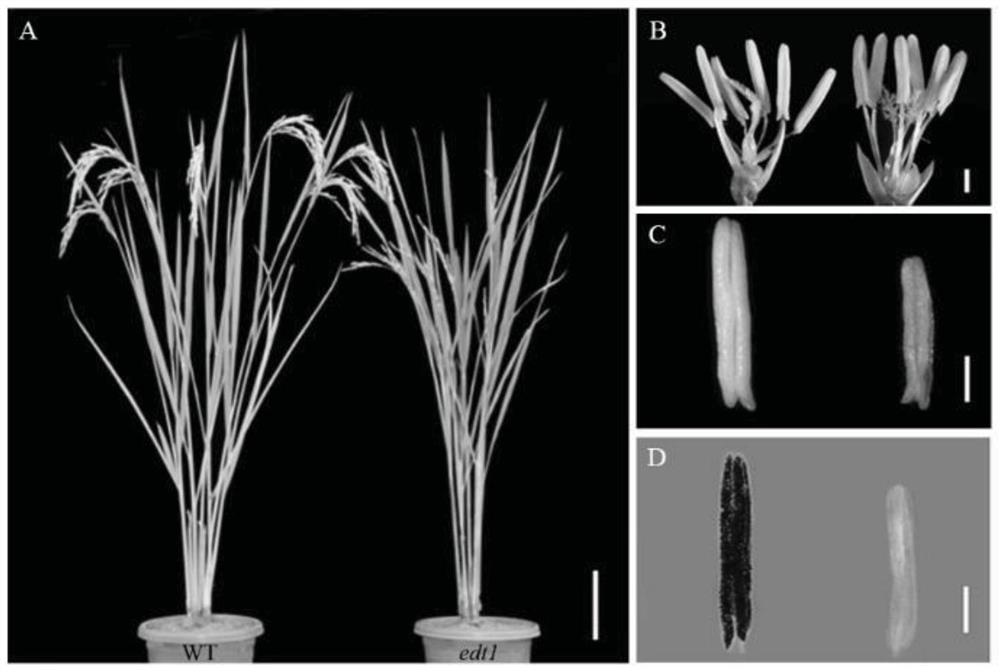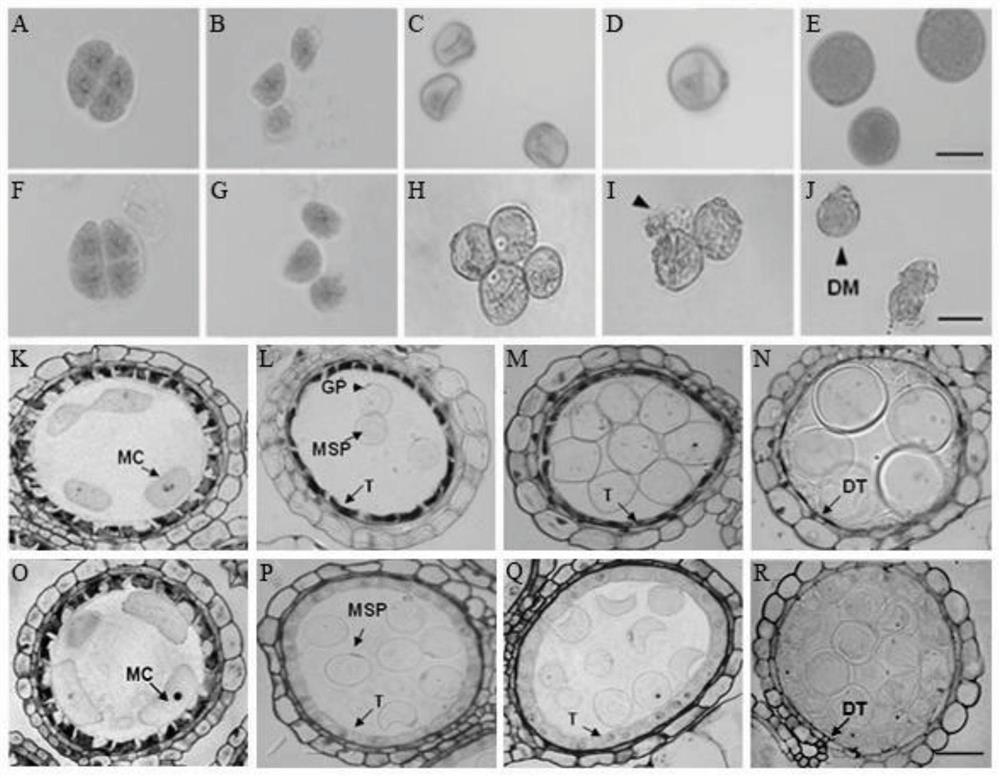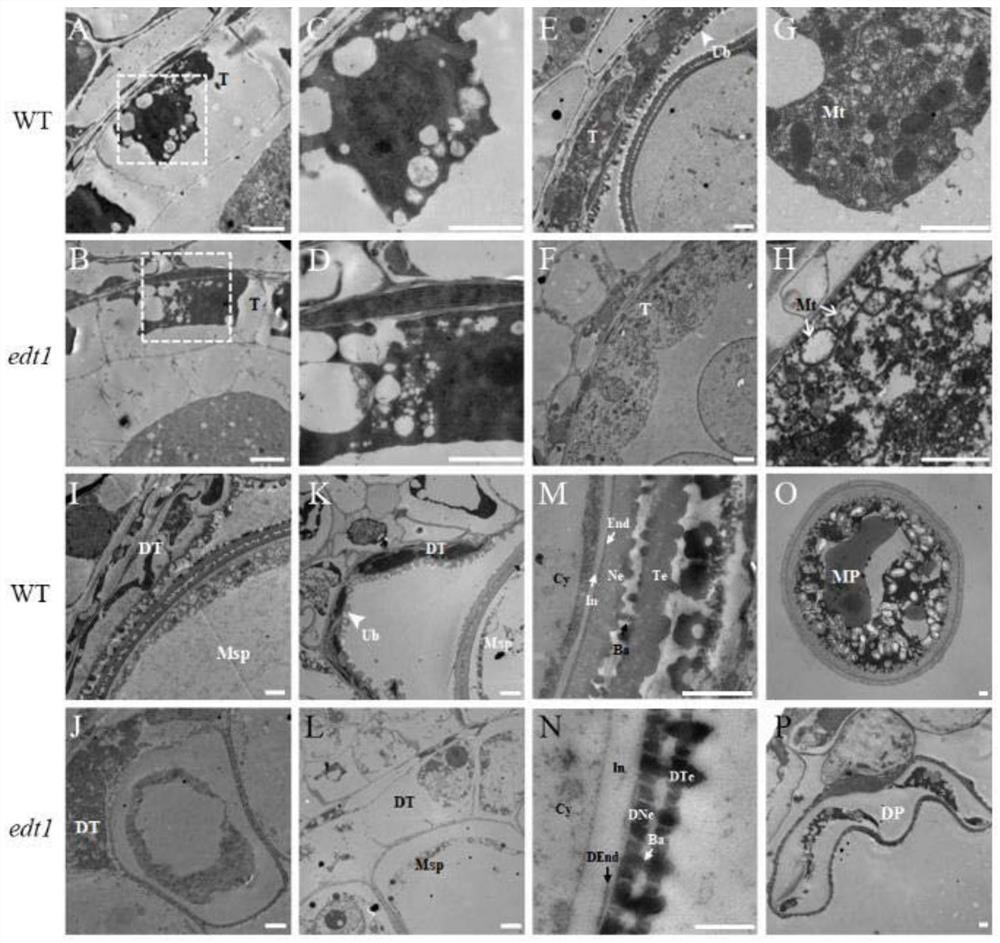Rice anther development regulation gene EDT1 and application thereof
A technology for EDT1 and gene regulation, applied in the application field of rice anther development-related protein EDT1 and its coding gene, can solve the problem of less research on ACL, and achieve the effect of strong stress resistance and wide adaptability
- Summary
- Abstract
- Description
- Claims
- Application Information
AI Technical Summary
Problems solved by technology
Method used
Image
Examples
Embodiment 1e
[0055] Phenotype observation of embodiment 1edt1 mutant and map-position cloning of EDT1 gene
[0056] (1) The phenotype of the edt1 mutant was observed to clarify its mutation type
[0057] The edt1 mutant was obtained from the indica rice variety IR64 through tissue culture. After field observation, we found that the defective phenotype of the mutant (short plant height, short and white anthers) existed stably ( figure 1 , A, plant phenotypes of wild type and edt1 mutant after heading; B, spikelets of wild type and edt1 mutant after removing palea and lemma; C, anthers of wild type and edt1 at heading stage; D, wild Anthers of type and edt1 use iodine-potassium iodide (I 2 -KI) solution staining), the mutants were ultimately completely sterile because they could not form normally fertile pollen grains. After acetic acid magenta staining, it was found that in the edt1 mutant, after meiosis, microspores were released from the tetrad as in the wild type, but then developmenta...
Embodiment 2
[0066] Example 2 EDT1 participates in the degradation process of tapetum in anther
[0067] We analyzed the anther walls of wild-type and edt1 mutant anthers by TUNEL assay and comet assay, respectively. The experimental results found that in the wild-type tapetum cells, TUNEL positive signal began to appear at stage 8 (during meiosis), and a strong TUNEL signal was detected during stage 9 (microspore stage). In the mutant, we detected TUNEL positive signal at the 7th stage, and the TUNEL signal was the strongest at the 8th stage, and then the signal gradually disappeared ( Figure 4 , Detection of anther DNA fragmentation from stage 5 (S5) to stage 10 (S10) of wild-type (A-C, G-I) and edt1 mutants (D-F, J-L). Red fluorescence indicates propidium iodide (PI)-stained nuclei. Yellow fluorescence is an overlay of TUNEL positive nuclear staining (green) and propidium iodide (red). Arrows in F, G, H, J show TUNEL positive signal in tapetum cells). The comet experiment quantifie...
Embodiment 3
[0068] Example 3 EDT1 affects oxidation-reduction balance and energy metabolism in anthers
[0069] Staining experiments on anthers by NBT dyes found that in edt1, O 2 .- Consistently high levels of ( Figure 6 A). Subsequently, we observed the paraffin sections of anthers at the ninth stage, and found that O 2 .- Mainly present in the tapetum cells ( Figure 6 B-C). For the quantitative detection of O 2 .- Through WST treatment, quantitative detection found that O in S10 and S11 stages in edt1 anthers 2 .- The deletion was significantly higher than that of the wild type ( Figure 6 D). According to the above experimental results, we speculate that the tapetum degradation mode of edt1 is different from that of the wild type, and its degradation may be caused by insufficient energy in cells. It was found by high performance liquid chromatography that the amount of ATP in the edt1 mutant was significantly lower than that of the wild type at the 8th and 9th periods; a...
PUM
 Login to View More
Login to View More Abstract
Description
Claims
Application Information
 Login to View More
Login to View More - R&D
- Intellectual Property
- Life Sciences
- Materials
- Tech Scout
- Unparalleled Data Quality
- Higher Quality Content
- 60% Fewer Hallucinations
Browse by: Latest US Patents, China's latest patents, Technical Efficacy Thesaurus, Application Domain, Technology Topic, Popular Technical Reports.
© 2025 PatSnap. All rights reserved.Legal|Privacy policy|Modern Slavery Act Transparency Statement|Sitemap|About US| Contact US: help@patsnap.com



